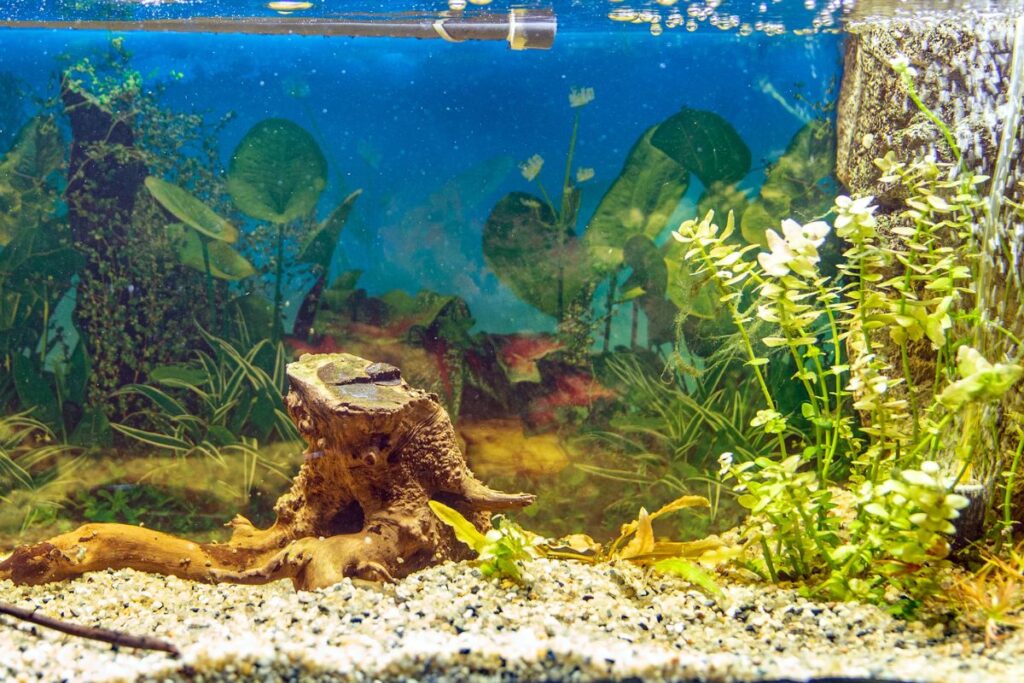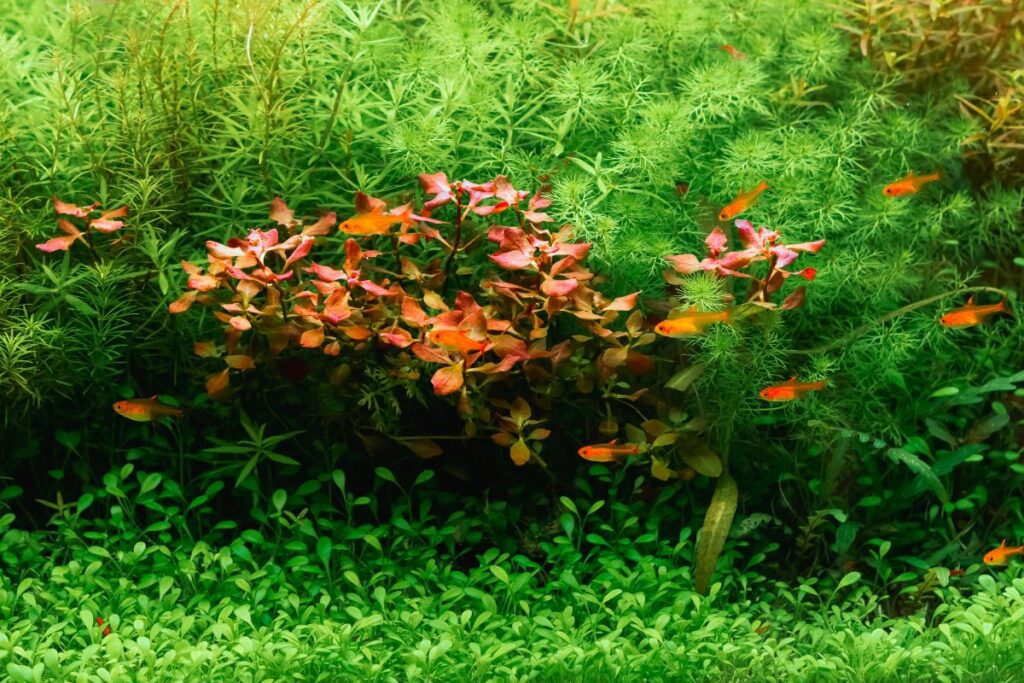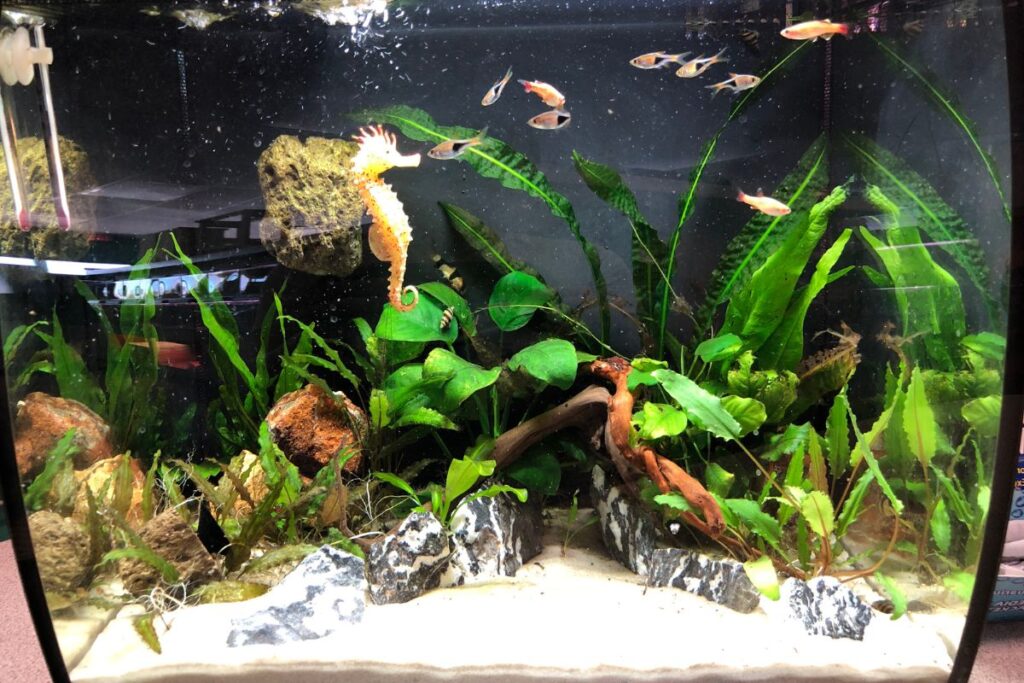For the aspiring aquarist, there’s nothing quite like adding plants to an aquarium. Not only do they bring beauty and vibrancy to the tank, but they also help provide a sense of security for fish by providing hiding spots and oxygenating the water. But without proper anchoring, these plants can easily float away or drift around in the current. To ensure your aquatic garden stays put, here are 10 ways how to anchor aquarium plants securely!

How To Anchor Aquarium Plants
We’ll go through everything you need to know about properly securing your underwater foliage – from substrate-based solutions such as planting cups and pots all the way up to using weighted decorations and rocks. Whatever method you choose, we guarantee that with our tips you’ll have no problem keeping your plants firmly rooted in place!
Contents
- 0.1 Use A Generous Amount Of Substrate
- 0.2 Add Weight Around The Plant Base
- 0.3 Tie Aquarium Plants To Driftwood
- 0.4 Tie Aquarium Plants To Rocks
- 0.5 Use Plastic Mesh For Carpet Plants
- 0.6 Keep Live Plants In Their Nursery Pots
- 0.7 Use Ceramic Plant Anchors
- 0.8 Use Suction Cups
- 0.9 Plant Them In Crevices
- 0.10 Use Fish-Safe Adhesive
- 1 Why Do Aquarium Plants Need To Be Anchored?
- 2 Conclusion
Use A Generous Amount Of Substrate
When anchoring aquarium plants, substrate choice and depth are key. Aquariums come in a variety of shapes and sizes, so it is important to choose the right type of substrate for your tanks. The most common types of substrate used in an aquarium environment include sand, gravel, pebbles, marbles and clay balls.
Aquatic plant roots need enough space to grow properly while staying firmly attached to the ground. To make sure that this happens, use a generous amount of substrate with a planting depth between 2-5 inches depending on the size of the tank. Besides, when planting aquatic vegetation into the substrate always ensure that you press down gently around each root system making sure not to damage any delicate stems or leaves. With proper installation techniques and using adequate amounts of appropriate substrates, you can be confident that your planted aquarium will remain healthy and anchored for many years to come!
Add Weight Around The Plant Base
Another method to anchor aquarium plants is by using plant weights. Plant weights, which are typically made of lead or other non-toxic materials, can be wrapped around the base of the plant’s stem or roots, holding them securely in place. Tying the plants to a heavy object can be done using fishing line, thread, or even rubber bands, depending on the size and type of plant.
This method allows the plant to establish a strong root system in the substrate over time, ensuring that it stays anchored in place. It’s essential to monitor the plant’s growth and adjust the anchoring as needed to ensure their continued health and stability in the aquarium.
Tie Aquarium Plants To Driftwood

If you’re looking for a more attractive option, tying aquarium plants to driftwood is an excellent idea. It provides both aesthetic appeal and practicality when it comes to keeping your plants in place. When you tie aquarium plants to driftwood, make sure that you use sturdy knots so they don’t come undone easily with water flow or current.
When anchoring your aquarium plants with driftwood, pay attention to the root systems of each plant as well as the planting depth. Make sure that all the roots are planted into the substrate at a good depth and that light levels aren’t too high which could damage them. Taking these steps will ensure that your plants remain firmly anchored in their spot without worrying about them floating away!
Tie Aquarium Plants To Rocks
Tying aquarium plants to rocks is one of the most popular methods for anchoring them in place. This method relies on using alternative materials such as a fishing line or nylon thread, which will not harm your plants and can be easily removed when necessary.
Plus, tying aquarium plants to rocks provides several benefits to both the plants and the overall aquatic environment. For one, it allows the plants to grow in a more natural manner, as they can spread their roots around the rock and establish themselves firmly in the substrate. This not only improves the aesthetics of your aquarium but also enhances the water quality, as the plants contribute to the absorption of harmful toxins and waste materials.
This method also makes it easier to rearrange or relocate the plants without causing any damage to their root systems. By securing the plants to rocks, you can create a beautiful aquascape that mimics a natural underwater environment, providing a more comfortable and stimulating habitat for your fish and other aquatic inhabitants.
Use Plastic Mesh For Carpet Plants

To anchor aquarium plants using plastic mesh for carpet plants, begin by selecting a suitable mesh with small openings to hold the plant’s roots and prevent them from floating. Cut the mesh into the desired size and shape to fit the aquarium’s bottom or specific area where the carpet plants will grow. Next, carefully insert the plants’ roots through the openings in the mesh, ensuring that they are securely attached. Place the mesh with the attached plants on the substrate in the aquarium, and add a thin layer of substrate on top of the mesh to conceal it. Over time, the plants will spread and grow, creating a lush carpet effect in your aquarium.
This method of anchoring aquarium plants is not only effective but also safe for your fish and other aquatic life. The plastic mesh is inert and will not leach harmful chemicals into the water. Additionally, the mesh provides a stable base for the plants to grow on, preventing them from being uprooted by the activity of the fish or water currents. As the plants grow, their roots will intertwine with the mesh, creating a more robust and stable carpet that can withstand the movement of fish and other inhabitants in the aquarium. Overall, using plastic mesh for anchoring aquarium plants is a simple and effective way to create a beautiful and thriving underwater environment for your aquatic pets.
Keep Live Plants In Their Nursery Pots
Keeping live plants in their nursery pots is a great way to anchor them firmly into your aquarium. This method of planting helps stabilize the roots and ensure that they don’t get swept away by water flow, while still receiving ample fertilization and light exposure. It also provides protection from over-grazing fish, since the plants are securely held within their own pot.
In addition to keeping your live plants safe, this technique can help maintain balance in your tank’s ecosystem. Without proper anchoring, plant debris would become suspended in the current which could lead to an increase or decrease of oxygen levels as well as pH imbalances. By placing each species of plant in its own container, you’ll be able to keep better control over these environmental factors. In short, it’s wise to give your aquatic plants a good home so they can thrive!
Use Ceramic Plant Anchors
Ceramic plant anchors are specifically designed to help secure aquarium plants to the bottom of the tank, ensuring that they don’t float away or become dislodged by the activities of the fish or the water current. These anchors are made from non-toxic, aquarium-safe materials that blend well with the natural environment of the tank, making them an ideal choice for aquarists aiming to create a beautiful and stable underwater landscape.
Using ceramic plant anchors is quite simple – you just need to wrap the base or the roots of the plant around the anchor and gently press it into the substrate. The weight of the anchor will hold the plant in place, allowing it to establish its root system and grow healthily. As the plant grows, the anchor will continue to provide support and stability, ensuring that the plant remains in its desired location within the aquarium. Additionally, these anchors are reusable, making them an eco-friendly and cost-effective option for maintaining the layout of your aquarium. Overall, ceramic plant anchors are a practical and reliable solution for keeping aquarium plants firmly in place while also promoting their healthy growth.
Use Suction Cups
Anchoring aquarium plants using suction cups is a popular method for creating a stable and visually appealing aquatic environment. This method allows you to secure your aquarium plants at specific positions and depths within the tank, providing a more natural and organized appearance. Additionally, using suction cups for anchoring reduces the risk of dislodging the plants accidentally while cleaning or rearranging the tank.
To anchor aquarium plants using suction cups, start by selecting the appropriate suction cups that can hold the weight and size of your plants. You can purchase these at pet stores or online, and they are available in various sizes and strengths. Make sure that the suction cups are made of aquarium-safe materials, such as silicone or rubber, to avoid introducing harmful substances into the water.
Before attaching the suction cups, clean the area of the aquarium glass where you want to secure the plants, as well as the suction cups themselves. This will ensure proper adhesion and eliminate any debris, algae, or residue that might interfere with the suction. To attach the plant to the suction cup, you can either tie the plant’s stem or rhizome to the suction cup using a fishing line or thread, or you can purchase suction cups with built-in clips specifically designed for holding aquarium plants.
After attaching the plant to the suction cup, submerge the suction cup into the water, and press it firmly against the glass surface of the aquarium, ensuring that all air bubbles are expelled. Hold the suction cup in place for several seconds to create a strong bond. Keep in mind that you may need to reapply pressure to the suction cup occasionally, as the suction may weaken over time, especially if the aquarium glass becomes dirty or algae-covered.
Anchoring your aquarium plants using suction cups not only enhances the visual appeal of your aquatic environment but also provides a stable and secure habitat for your fish and other aquatic creatures. This method is easy to implement and maintain, making it an ideal choice for both beginner and experienced aquarium enthusiasts.
Plant Them In Crevices

Anchoring aquarium plants by planting them in crevices is an excellent method to ensure the proper growth and stability of these plants. This technique not only provides a strong foundation for the plants but also enhances the natural appearance of the aquarium, giving it a more realistic and appealing look. To begin the process, carefully select the plants that are suitable for your aquarium, keeping in mind their specific requirements such as lighting, temperature, and water conditions.
Start by preparing the aquarium and creating a stable and suitable environment for the plants. Ensure that the substrate is an appropriate type and depth for the selected plants. Next, choose the crevices in rocks or driftwood where you would like to place the plants. These crevices should be of adequate size and depth to accommodate the plant’s roots and provide support as they grow. Gently insert the roots of the plants into the crevices, making sure they are firmly positioned. You may use a pair of tweezers or your fingers to gently push the roots deeper into the crevice.
By planting your aquarium plants in crevices, you can create a visually appealing underwater landscape that mimics the natural environment, providing a comfortable and stimulating habitat for your aquatic creatures.
Use Fish-Safe Adhesive
When it comes to choosing an adhesive suitable for use in aquariums, there are several types available with varying properties that should be considered. Coatings designed specifically for safety in fish tanks often have added benefits such as anti-fungal agents or UV protection which will ensure better plant health over time.
Also, when selecting planting techniques, using adhesives can help hold the substrate together and provide more stability than other methods like stones or weights alone. The type of anchor chosen must also be appropriate for the material being used; plastic anchors may be preferable if live rocks are used instead of artificial ones due to potential sharp edges and holes present on natural rock surfaces which could damage delicate roots.
Ultimately, by understanding the needs of both your fish tank inhabitants and plants, you can choose the most optimal solution for securely attaching all your aquarium’s underwater decorations!
Why Do Aquarium Plants Need To Be Anchored?
Anchoring aquarium plants is an important step in creating a healthy and thriving aquatic environment. Plants are essential for maintaining good water quality, they provide shelter to fish, and they also add beauty to the tank. So why do aquarium plants need to be anchored?
The selection of aquarium plants that you choose will determine if it needs anchoring or not. Some aquarium plants have roots that help them attach themselves naturally to surfaces such as rocks, driftwood, and gravel; however, some species require additional support. The root structure of certain aquatic plants can become weak over time due to their planting depth, light requirements, and water quality conditions within the tank. To ensure these fragile rooted plants remain secure, the fish-safe adhesive must be used when attaching them to any other object in the tank. This helps keep them from floating away or getting pushed around by strong currents or filter outflows.
Conclusion
It’s important to anchor aquarium plants in order to keep them healthy and secure. Without anchoring, they can drift around the tank and become uprooted or tangled with other plants. There are many different ways to do this depending on what type of plant it is. We’ve outlined some of the most common methods, such as adding substrate and weight around the base, tying the plants to rocks or driftwood, using plastic mesh for carpet plants, suction cups, planting them in crevices, and fish-safe adhesive. With these tips, you should be able to easily anchor your aquatic plants so that they will remain happy and healthy for years to come!
